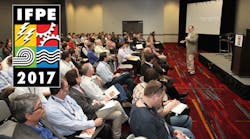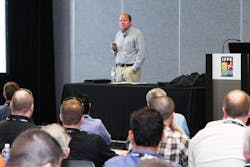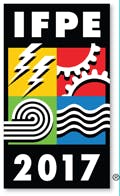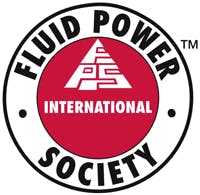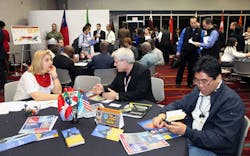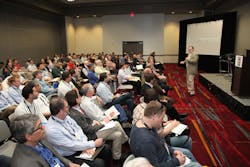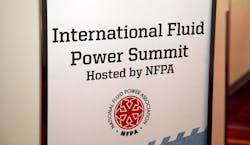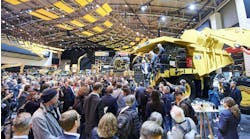This file type includes high resolution graphics and schematics when applicable.
Keynote speakers at this yearâs show will focus on energy-saving methods and future small systems useful for robotics and automation.
Taking place March 7-11 at the Las Vegas Convention Center, the International Fluid Power Expo (IFPE) will offer educational opportunities targeting multiple areas of the industry. In addition to keynote and plenary sessions, college-level courses and seminars will start the day before the conference. On March 6 and 7, four courses will cover the fundamentals of electrohydraulic systems, the basics of hydraulic fluids, hydraulic-system designs for mobile applications, and more advanced electrohydraulic systems.
The Energy Efficient Hydraulics and Pneumatics Conference, to be led by three fluid power organizations, will kick off the first day of the conference, with keynote and plenary sessions beginning Wednesday, March 8. On Friday, Future Outlook presentations will explore fluid power in small-scale robotics, small integrated systems, and soft robotics and prostheses.
College courses are priced at $250. Full Session Passes cost $375, and include any sessions from Wednesday through Friday within the Energy Efficient Hydraulics and Pneumatics Conference. The $175 Session Day Pass includes any sessions on a selected day (Wednesday, Thursday, or Friday) within the aforementioned conference.
More information about educational opportunities at IFPE is listed below, and additional details can be found here.
College-Level Courses
IFPE’s college-level courses offer hands-on technical knowledge on the effective use of hydraulics in mobile equipment. These half-day courses will benefit practicing engineers and others involved in design and manufacturing processes. Sessions will be held March 6 and 7 in the South Hall of the Las Vegas Convention Center.
Monday, March 6
Fundamentals of Electrohydraulic Systems—8:00 a.m. to 12:00 p.m.
This presentation is intended to increase awareness of the fundamental concepts of fluid power technology. The presentation covers some rules of physics about fluid pressure and flow, followed by discussion into the generic structure of a hydraulic system in addition to the construction and principle of operation of main components such as pumps, motors, valves, cylinders, and rotary actuators. The lecture concludes by detailing how to grab all of these components in the form of a system that works safely and efficiently.
Presenter: Dr. Medhat Khalil, director of professional education, Milwaukee School of Engineering
Cost: $250
Hydraulic Fluid Properties, Efficiency, and Contamination Control—1:00 to 5:00 p.m.
Participants will learn about the composition of oils, properties of lubricants, and how hydraulic fluids can affect machine performance. Conventional, multi-grade, synthetic, and biodegradable fluids will be discussed. It will present research studies examining fluid-efficiency effects in hydraulic motors, piston, and gear pumps, and outline the principles of oil analysis and filter selection. The seminar concludes with case studies that demonstrate how filter debris analysis can be used to troubleshoot hydraulic-system contamination control problems.
Presenter: Paul Michael, research chemist, Milwaukee School of Engineering
Cost: $250
Tuesday, March 7
Hydraulic System Design Strategies for Mobile Applications—8:00 a.m. to 12:00 p.m
This course is divided into four different topics:
1. Developing Motion Control Training Strategies for Your Workforce
This presentation explores the breadth of the motion control industry, identifies technology trends, and develops a strategy to fill the knowledge gap of stakeholders. Everyone from end-users and maintenance technicians to system designers are challenged with producing results in a changing technology climate. Managers are faced with expensive and time-consuming options to develop skilled human resources. This session will help identify the appropriate strategy for subject-matter experts to efficiently develop critical skills needed in our industry.
Presenter: Bogdan Kozul, technical training manager, Parker Hannifin Corp.
2. Leveraging Internet of Things (IoT) in Mobile Hydraulics
This session will explore the impact of the Internet of Things (IoT), intelligent components, and component connectivity on mobile hydraulics. What does it mean to OEMs, dealers, and end-users? How does it impact today’s equipment? What can we expect in the near future? How will IoT open new revenue streams and services? This may be the most exciting technology shift in the mobile hydraulics field in years—do you understand how IoT will affect your business? Are you ready to talk about SaaS (software as a service), cloud connectivity, gateways, connected components, data security, telematics, remote monitoring, or mobile applications? Is it time to leverage IoT into your equipment and solutions?
Presenter: Art Donaldson, business unit manager, IoT and connectivity, Parker Hannifin Corp., Hydraulics Group
3. Global Shield Coating: Improved Corrosion Resistance for Critical Equipment
This presentation provides an overview of Parker Hannifin’s Global Shield coating, which is a high-performance coating that provides high corrosion and wear resistance to extend the service life of critical equipment. Discussed will be the internal and independent testing that was conducted, which reveals how the coating fared versus other common coatings. This session will also deliver general information about the characteristics of the coating and current applications.
Presenter: Michael Sell, product manager, Parker Hannifin Corp., Cylinder Div.
4. Electro Hydrostatic Actuation—Highly Efficient Implement Solution with Energy Recovery
Many next-generation off-road machines reduce energy loss and improve productivity by incorporating hybrid electric approaches with energy storage. An efficient implementation of a hybrid electric approach is essential to achieve maximum improvement potential. This presentation will introduce electrohydrostatic actuation outlining basic operation, highlighting unique characteristics, and comparing benefits with alternative approaches. A summary of test results from application experience will be included.
Presenter: Dale Vanderlaan, senior program manager, Parker Hannifin Corp.
Cost for all four parts: $250
Electrohydraulic System Design and Control—1:00 to 5:00 p.m.
State-of-the-art hydraulic drives have reached the same automation level as their electromechanical brethren. The evolution of IoT (Industry 4.0) did not stop in front of hydraulics. Come along for a user journey presenting the potential of state-of-the-art technologies such as electrohydraulic drives, simulation, and IoT technologies:
• Design—Consideration and system configuration for electrohydraulic systems
• Validate—Model-based engineering and electrohydraulic system simulation
• Connect—The potential of connected hydraulics
• Data Sources—Dedicated sensors; drive systems as “virtual” sensors (computed); sensor nodes
The characteristics and advantages of these new approaches will be presented and proven by some live demonstrations.
Presenters: Janette Kothe, technical sales support—Industry 4.0, Bosch Rexroth Corp. and Michael Liedhegener, manager, Simulation Group, Technical Sales, Bosch Rexroth Corp.
Cost: $250
Energy Efficient Hydraulics and Pneumatics Conference
Keynote and Plenary Sessions
Wednesday, March 8
Keynote:
Methodologies to Improve Energy Efficiency in Fluid Power—12:00 to 1:00 p.m.
The keynote will highlight the trends sweeping through mobile and industrial applications in efforts to improve system productivity and overall efficiency. Speaker Chris Schottler will provide an overview on how machines can be optimized at the system and component level to improve hydraulic efficiency, offering examples to illustrate his points. He will also share highlights of different technologies and architectures that are currently improving system efficiency, or will in the future.
Presented by Chris Schottler, engineering manager, Advanced Technology, Eaton Corp.
Hydraulics:
Using Electronics to Improve Efficiency and Productivity—1:15 to 1:40 p.m.
Embedded Electronics is more than a way to perform late differentiation on assembly lines and fine tuning in the field. Every year, microcontrollers get smaller and smaller while their power keeps increasing. Sequential management of the task is no more the main expectation; vehicles are deciding how they have to accommodate all of the parameters and real-time values to perform as expected with a minimum use of energy and noise generation. Sensors, development methods, standards, and technology are pushing engineers on a continuous improvement path to give end-users the best performance with the optimal use of all the components of their machines. These aspects will be reviewed during the session.
Presented by Cedric Magnien, systems, electronics, and vehicle integration manager, Poclain Hydraulics
Pneumatics:
ISO Standards for Energy and Power Loss in Fluid Power Components and Systems—1:15 to 1:40 p.m.
The electrical industry has power ratings for every motor, transformer, and light bulb. Such is not the case for the fluid power industry, which also lacks standards for measuring power consumption. It is underway, though: ISO Technical committee 131 for fluid power is developing standards that provide methods to measure the power consumption of fluid power components and systems.
This presentation describes how the basic energy equation, taught in the first course of fluid mechanics, can be used to develop equations to measure the power consumption of fluid power components. Examples of power consumption in hydraulic filters, hydraulic valves, and pneumatic valves are shown. In addition, there’s a demonstration of how the thermodynamic concept of available energy is applied to analyze the energy efficiency of a pneumatic system.
Measuring power consumption is important. If we conclude that the level of energy consumed by our components is too high, we will inevitably make improvements to the products, or make recommendations on their application. But, how will we know if we are successful unless we have standards to measure the improvements?
Presented by John Berninger, retired global engineering manager, Parker Hannifin Corp.
Hydraulics:
Harmonizing Your Electro-Hydraulic Solutions—1:45 to 2:10 p.m.
As changes in mobile-system technology advance the hydraulics industry toward the “electronification” of machines, there can be challenges in understanding what approach to take to provide reliable, safe, and repeatable functionality of the machine. This session offers insight into overcoming those challenges by asking the right questions when applying electrohydraulic solutions, ensuring that electronics and hydraulics complement each other on the machine.
Presented by Terry Hershberger, director, sales, product management, mobile applications, Bosch Rexroth Corp.
Pneumatics:
The Impact of Modern Controls in Production Processes - Compressed Air System Energy Efficiency—1:45 to 2:15 p.m.
When someone in the air-compressor field talks of pneumatic controls, the immediate thought is the proper operation of air-compressor capacity controls integrated with an effective central control system. This is important, because it’s the only way that less compressed air used in the production process areas can translate into reduced input energy. More often than not, though, we see many processes and air-using machinery not taking advantage of modern, more-advanced control technology—which can significantly lower a plant’s overall power consumption. This is particularly applicable to operations such as packaging machines, dust collectors, blow-off operations, air-operated pumps, vacuum generators, palletizers, and cabinet coolers.
Presented by Hank Van Ormer, owner, Van Ormer Consulting Inc.
IFPE will also be a place for professionals to exchange ideas and hold conversations after sessions.
Hydraulics:
Traction Control Methods: Different Ways to Improve Efficiency—2:15 to 2:45 p.m.
Hydrostatic transmissions provide flexibility in designing vehicle propulsion drives. Unlike mechanical transmissions, hydrostatic drives offer inherent differential torque and motion control. However, the different choices offered by this flexibility can complicate which features to adopt when traction control is required.
Flow, pressure, and displacement controls can be considered, with some limitations regarding the specific applications requirements and hydrostatic technologies used. Those options will be reviewed during the session, with illustrations based on simulations and real cases.
Presented by Jean Heren, platform business manager, Poclain Hydraulics
Pneumatics:
Improving Manufacturing Processes and Air Efficiency with the Use of New Smart Pneumatic Technologies—2:20 to 2:45 p.m.
The Industrial Internet of Things (IIoT) is transforming the factory floor. IIoT helps manufacturing companies boost asset utilization, save energy, provide better services, and improve quality. Smart pneumatics can play a key role in the Industrial Internet when networked manifolds are monitored to become a convenient data source. Big Data analytics use this pneumatic data to create actionable insights and keep plant personnel informed with web pages, dashboards, reports, and alerts that focus on machine productivity, predictive alerting, air usage, and energy consumption. An example solution presented in this session will illustrate a practical method that uses pneumatic data within the confines of the Industrial Internet of Things to benefit machine builders and manufacturers.
Presented by Spencer Cramer, CEO, ei3 Corp.
Hydraulics:
Increasing Energy Efficiency of an Industrial Hydraulic System—3:00 to 4:00 p.m.
This session will examine some of the areas where hydraulic energy inefficiencies occur, and discuss key items for evaluating an industrial hydraulic system to determine recommendations to improve efficiency. Some specifics look at the sizing of prime movers, selection of fluid, contamination control, pump design, plus considerations for selecting electronic controls, valves, and actuators.
Presented by Tom Blansett, consultant
Pneumatics:
Energy Savings Opportunities for Pneumatic Systems—3:00 to 4:00 p.m.
This course was developed for the benefit of plant managers, design engineers, and maintenance personnel who are concerned with, or responsible for, controlling the costs and environmental impact of excessive energy use in their given facility. Topics covered include establishing an energy-conservation program, monitoring flow and pressure, and identifying target areas for savings such as leak remediation, air blow optimization, excessive pressure and unregulated usage, intermittent demand and idle-mode savings, and energy-intensive usage of compressed air.
Presented by Jon Jensen, energy conservation group manager, SMC Corp. of America
Thursday, March 9
Keynote:
Innovative Application of Energy Efficient Fluid Power—12:00 to 1:00 p.m.
Fluid power does the work that transforms the world around us in factories, fields, and construction sites. With such an important role to play in developing our modern society, energy efficiency is always an important concern. In his keynote, Eric Bretey will give an overview of fluid power energy-consumption trends in the United States. He will also highlight current activities and advances in fluid power research, as well as share innovative technologies and applications that will shape how fluid power is utilized in future off-road machines.
Presented by Eric Bretey, engineering manager, integrated solutions, Danfoss Power Solutions
Pneumatics:
Energy Efficiency, Part 1: Corporate View—1:15 to 1:45 p.m.
This case study examines how Frito-Lay views energy efficiency as it relates to compressed air. The presentation will cover the firm’s corporate programs (compressed-air use tracking, electric efficiency scorecards, compressed-air leak repair, and compressed-air surveys), strategies for efficient operation of the compressed-air system (supply and demand side), and approaches to testing new compressed-air technologies. Also in the works will be an overview of several corporate-wide projects that have been executed.
Presented by Bryan Seitz, sustainability associate principle engineer, Frito-Lay – HQ Supply Chain
Hydraulics:
Assessing a Mobile Hydraulics System Design for Energy Efficiency—1:15 to 2:00 p.m.
This session will look at some of Hydra Tech’s hydraulic systems and show ways to cost-effectively improve efficiency. It will compare examples of traditional circuits and the company’s improved circuit. Discussion also will surround how the actual placement of components and how the circuit is plumbed affect system efficiency and temperature.
Presented by Ernie Parker, Hydra Tech Inc.
Pneumatics:
Energy Efficiency, Part 2: Plant—1:50 to 2:20 p.m.
Abstract not yet submitted.
Presented by Sonny Martin, Frito-Lay
Hydraulics:
Sensor Technology: Enabling Hydraulic Energy Efficiency and Performance—2:05 to 2:50 p.m.
Built-in machine intelligence opens new opportunities for safe, clean, and efficient operation of hydraulic equipment. Pressure sensors in hydraulic and transmission systems enable surveillance and control of all vital processes to ensure maximum performance, reduce downtime, and improve fuel efficiency.
Presented by Magnus Hansson, Danfoss Industrial Automation
Pneumatics:
What We Did to Maximize Our Compressed Air System—2:25 to 3:10 p.m.
This session details Continental Tire’s success stories about how it reduced compressed-air generation costs and usage thanks to an energy-monitoring system; an aggressive air leak repair program; re-piping of an outgrown air-delivery system; and installing new compressors dryers, and controls.
Presented by Don Grimes, energy supervisor, Continental Tire The Americas, LLC
Hydraulics:
Transforming Fluid Power—3:00 to 4:00 p.m.
We are about to enter a new era in the use of fluid power. To be successful in understanding the changes that are coming, we will need to rethink some of our most cherished notions about power transfer by fluids. Is “Flow Means Go” an accurate explanation of actuator velocity?
Using the power formula, we will discover ways to control velocity without restrictive flow controls. We will learn how to allow an actuator to only draw the amount of power needed for the task at each moment. In addition, we will find we can use all the available energy in both gas charged and weighted accumulators while still controlling speed.
Presented by Dan Helgerson, Perisseuma Energy
Pneumatics:
Compressed Air Energy Cost Reduction at Briggs & Stratton—3:15 to 4:00 p.m.
Abstract not yet submitted.
Presented by Jess Sumrall, Briggs & Stratton
Friday, March 10
Keynote:
Opportunities and Challenges in Making Human Assist Fluid Power Systems Part of the Coming Robot Revolution—12:00 to 1:00.
Automotive assembly lines with protected heavy-duty industrial robots have dominated the robotics arena. However, in the new paradigm, thanks to developments in vision systems and computational power smaller-scale robotics, opportunities are rapidly evolving to enhance and augment human endeavor. This presentation offers an overview of this evolution and discusses the technological merits of fluid power systems for robotics. Furthermore, it will discuss future developments and implications of human-centric robotics, which will provide context for remaining session presentations.
Presented by Nic Copley, vice president—technology & innovation, Parker Hannifin Corporation - Automation Group
Future Outlook:
Design Guidelines for Compact, Integrated Fluid Power Systems—1:15 to 1:40 p.m.
Fluid power on the small scale is more than simply shrinking large-scale components and systems. Modeling and simulation can be used to predict the size, weight, and efficiency of small-scale hydraulics being used to drive next-generation lightweight wearable robots. Along with describing guidelines to help the engineering designer optimize small-scale hydraulics, this presentation will describe a prototype hydraulic-powered, ankle-foot orthosis that has exceptional torque yet is still lightweight. It will also highlight where research and development is still needed in small-scale hydraulics.
Presented by William Durfee, professor and director of design education, University of Minnesota Department of Mechanical Engineering
Future Outlook:
Untethered Power Supplies—1:45 to 2:15 p.m.
Compact and capable power supplies for untethered human-scale fluid power machines continue to be a challenge. As applications involving human-machine interaction motivate new collaborative and soft robot architectures, the source of power for these inevitably fluid-powered machines must be adequately energy-dense, as well as satisfy a number of challenging constraints. This talk will present recent progress made in untethered power supplies for the next generation of human-scale fluid power applications.
Presented by Eric Barth, associate professor of mechanical engineering, Vanderbilt University
Future Outlook:
Soft Robotics and FREEs—2:20 to 2:45 p.m.
Inspired by the biology of flexible-yet-powerful organisms—such as the octopus and starfish, or tissue such as muscle—soft robotics replaces rigid and stiff actuators and structures with compliant fluid-filled designs. Popular McKibben actuators, or pneumatic artificial muscles, are one embodiment of Fiber Reinforced Elastomeric Enclosures (FREEs), which are constructed from a stretchy hollow elastomeric cylinder reinforced with helical fibers. By changing the angle of the fibers, FREE actuators can not only contract (such as with a McKibben muscle), but also extend, create torsion, or coil. This presentation will explore the use of FREEs to create robotic arms, powered orthotic devices, and exoskeletons.
Presented by Liz Hsiao-Wecksler, associate head of undergraduate programs and professor, University of Illinois
Future Outlook:
Noise, Vibration and Harshness: Sound Quality Issues in Hydraulics (Looking into the Future)—2:50 to 3:15 p.m.
What should interactive robots sound like? The question bears on more than just the noise and vibration that robots may generate—it also concerns the intended use environment of such robots, and how humans may use auditory clues to sense the action of these robots. Use of robots in therapeutic settings poses its own challenge for low-noise requirements. Not only should the sounds they produce not be threatening to patients, they must provide sufficient auditory cues for enhanced situational awareness for their operators/collaborators.
Presented by Ken Cunefare, professor, Georgia Institute of Technology
Future Outlook:
Panel Discussion and Q&A with the Audience—3:20 to 4:05 p.m.
Participants include Eric Barth, associate professor of mechanical engineering, Vanderbilt University; Ken Cunefare, professor, Georgia Institute of Technology; Liz Hsiao-Wecksler, associate head of undergraduate programs and professor, University of Illinois; and William Durfee, professor and director of design education, University of Minnesota Department of Mechanical Engineering.
Single Day Pass: $175—Includes any sessions in a single day (Wednesday, Thursday, or Friday) within the Energy Efficient Hydraulics and Pneumatics Conference.
Full Conference Pass: $375—Includes any session from Wednesday through Friday within the Energy Efficient Hydraulics and Pneumatics Conference.
World Fluid Power Summit Convenes at IFPE
The National Fluid Power Association (NFPA) will host the World Fluid Power Summit during the conference. On Thursday, March 9, at noon, the summit will bring together fluid power professionals for information sharing and education. It will take place in the Las Vegas Convention Center and include lunch for all attendees. Industry and association leaders from around the world will attend and present the latest fluid power market trends in their home markets. Seating is limited and advanced registration is required. Contact Eric Lanke, NFPA president and CEO, for more information or to register.
This file type includes high resolution graphics and schematics when applicable.
